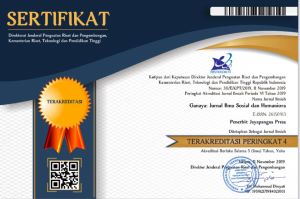Pengembangan Media Pembelajaran Pop Up Book Pada Materi Simbol dan Bunyi Sila Pancasila
DOI:
https://doi.org/10.37329/cetta.v7i4.3696Keywords:
Learning Media, Pop Up Books, Development, ADDIEAbstract
The limited use of teaching media and reliance on Student Worksheets (LKS) as the sole learning tool result in monotonous teaching methods, reducing students' interest, understanding, and creativity. This study aims to identify the development process and practicality of the Pop Up Book learning media. The research method used is Research and Development (R&D) with the ADDIE development model. The data analysis techniques employed include validity and practicality analysis of the Pop Up Book learning media. The research findings indicate that the development process of the learning media comprises several stages: 1) the analysis stage shows that the use of learning media is still minimal and less effective, leading to a lack of student interest, enthusiasm, and understanding of the material. 2) the design stage involves the creation of a Pop Up Book for the symbols and sounds of the Pancasila, including media selection, material collection from various sources, and the use of Pinterest and Canva applications to organize images and initial designs. The book is made using simple materials such as HVS paper, cardboard, and glue, with techniques producing attractive three-dimensional visuals that fit the theme. 3) the development stage aims to determine the validity of the learning media. Validation results by media and material experts indicate it is highly feasible, with average scores of 94% and 92%, respectively. 4) the implementation stage aims to assess the practicality of the learning media. Responses from students and teachers show that the Pop Up Book learning media is highly practical, with an average practicality score of 90.67%. It can be concluded that the Pop Up Book learning media for the symbols and sounds of the Pancasila is proven to be highly feasible (94%) and practical (90.67%) for enhancing students' interest and understanding.
References
Arikunto, S., & Jabar, C. S. A. (2009). Evaluasi Program Pendidikan: Pedoman Teoretis Bagi Mahasiswa Dan Praktisi Pendidikan. Jakarta: Bumi Aksara.
Arikunto, S., & Jabar, M. (2009). Pengembangan Media Pembelajaran Untuk Meningkatkan Pemahaman Siswa Dalam Mata Pelajaran Ilmu Pengetahuan Alam. Jurnal Pendidikan, 27(1), 45-56.
Arsyad, A. (2013). Media Pembelajaran. Jakarta: Rajawali Pers.
Cahyani, D. D., & Sari, M. (2020). Penggunaan Media Pop Up Book Dalam Menanamkan Pendidikan Moral Pada Anak Usia Dini. Journal Of Civics And Moral Studies, 5(1), 73-86.
Dzuanda. (2011). Design Pop-Up Child Book Puppet Figures Series? Gatotkaca?.Jurnal Library ITS Undergraduate, (Online), (Http:// Library.Its.Undergraduate.Ac.Id).
Febriyanti, E., & Ain, S. (2021). Analisis Kepraktisan Media Pembelajaran Dalam Pembelajaran Matematika Di Sekolah Dasar. Jurnal Teknologi Pendidikan, 19(3), 78-89.
Festiawan, R. (2020). Belajar Dan Pendekatan Pembelajaran. Universitas Jenderal Soedirman, 11.
Fathurroman, P., & Sutikno, M. S. (2010). Strategi Belajar Mengajar. Bandung: Refika Aditama.
Khoirotun, A., Fianto, A. Y. A., & Riqqoh, A. K. (2014). Perancangan Buku Pop- Up Museum Sangiran Sebagai Media Pembelajaran Tentang Peninggalan Sejarah. Jurnal Desain Komunikasi Visual, 2(1).
Masturah, E. D., Mahadewi, L. P. P., & Simamora, A. H. (2018). Pengembangan Media Pembelajaran Pop-Up Book Pada Mata Pelajaran IPA Kelas III Sekolah Dasar. Jurnal EDUTECH Undiksha, 6(2), 212-221.
Moto, M. M. (2019). Pengaruh Penggunaan Media Pembelajaran Dalam Dunia Pendidikan. Indonesian Journal Of Primary Education, 3(1), 20-28.
Ramli, M. (2012). Media Dan Teknologi Pembelajaran. Banjarmasin: IAIN Antasari Press.
Sa’dun, S. (2013). Kepraktisan Penggunaan Media Pembelajaran Berbasis Game Dalam Meningkatkan Pemahaman Materi Siswa. Jurnal Inovasi Pendidikan, 6(2), 99-110.
Sholikhah, A. (2017). Pengembangan Media Pop Up Book Untuk Meningkatkan Kemampuan Menulis Kreatif Pada Mata Pelajaran Bahasa Indonesia Materi Menulis Karangan Kelas V SDN Rowoharjo Tahun Ajaran 2016/2017. Simki-Pedagogia, 1(8), 1–8.
Sopian, A. (2016). Tugas, Peran, Dan Fungsi Guru Dalam Pendidikan. Raudhah Proud To Be Professionals: Jurnal Tarbiyah Islamiyah, 1(1), 88-97.
Sugiyono. (2012). Metode Penelitian Dan Penilaian Pendidikan (Pendekatan Kuantitatif, Kualitatif. Dan R&D). Bandung: Alfabeta.
Tafonao, T. (2018). Peranan Media Pembelajaran Dalam Meningkatkan Minat Belajar Mahasiswa. Jurnal Komunikasi Pendidikan, 2(2), 103–114.
Ulfa, M. S., & Nasryah, C. E. (2020). Pengembangan Media Pembelajaran Pop– Up Book Untuk Meningkatkan Motivasi Belajar Siswa Kelas IV SD. Edunesia: Jurnal Ilmiah Pendidikan, 1(1), 10-16.
Wiarto, G. (2016). Media Pembelajaran Dallam Pendidikan Jasmani. Yogyakarta: Laksitas.
Yuliarni, N. N., & Marhaeni, A. A. I. (2019). Pengaruh Penggunaan Media Pembelajaran Interaktif Terhadap Hasil Belajar Siswa Pada Mata Pelajaran Ppkn Di SD Negeri 004 Tanjung Pauh. Jurnal Pendidikan Dasar, 15(2), 123-135.
Yuliarmi, N. N., & Marhaeni, A. A. I. N. (2019). Metode Riset Jilid 2. Bali: CV. Sastra Utama
Downloads
Published
How to Cite
Issue
Section
License
Copyright (c) 2024 Atika Alfina Zumra, Laila Rahmi

This work is licensed under a Creative Commons Attribution-ShareAlike 4.0 International License.
An author who publishes in the Cetta : Jurnal Ilmu Pendidikan agrees to the following terms:
- Author retains the copyright and grants the journal the right of first publication of the work simultaneously licensed under the Creative Commons Attribution-ShareAlike 4.0 License that allows others to share the work with an acknowledgement of the work's authorship and initial publication in this journal
- Author is able to enter into separate, additional contractual arrangements for the non-exclusive distribution of the journal's published version of the work (e.g., post it to an institutional repository or publish it in a book) with the acknowledgement of its initial publication in this journal.
- Author is permitted and encouraged to post his/her work online (e.g., in institutional repositories or on their website) prior to and during the submission process, as it can lead to productive exchanges, as well as earlier and greater citation of the published work (See The Effect of Open Access).
Read more about the Creative Commons Attribution-ShareAlike 4.0 Licence here: https://creativecommons.org/licenses/by-sa/4.0/.





